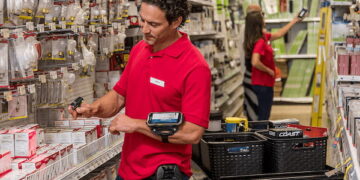Crédito: fuente
The spacecraft’s sampling arm, called the Touch-And-Go Sample Acquisition Mechanism, over the target sample site during a dress rehearsal in April.
NASA
Four years after launching from Earth, NASA’s Osiris-Rex on Tuesday made a historic and brief landing on potentially hazardous asteroid Bennu, over 200 million miles away.
The spacecraft traveled all that way to perform a short touch-and-go maneuver with the goal of collecting a sample from the asteroid’s surface and transporting it back to Earth for study.
We won’t know until Wednesday whether Osiris-Rex succeeded in grabbing a space science souvenir, but on Tuesday, NASA TV reported the spacecraft’s robotic sampling arm, named Touch-And-Go Sample Acquisition Mechanism (Tagsam), successfully touched down on Bennu for about 15 seconds. During the brief contact, it performed what amounts to a cosmic pickpocketing maneuver.
The spacecraft, which operates largely autonomously due to the 18-minute communications delay with mission control on Earth, fired a canister of gas through Tagsam that should have disrupted the surface of Bennu enough for a sample to make its way up into the arm’s collector head.
The team’s goal is to collect about 60 grams of dust, dirt and pebbles from the surface of Bennu. To determine if that goal has been met, in the coming hours Osiris-Rex will maneuver to a safe position and then move its arm into position to take photos of the collector head and weigh how much mass lies within.
There’s no guarantee Osiris-Rex has collected a significant sample. As the spacecraft approached and then spent two years orbiting and surveying Bennu, it became clear this tiny world is different than what scientists expected. The team hoped to find a number of sandy surfaces ideal for sampling, but it turns out Bennu is a rubble pile, with a rugged terrain strewn with boulders.
The Osiris-Rex team celebrates at the moment of touchdown.
NASA TV
Osiris-Rex was designed to touch down on a flat, even surface, but Bennu is so rocky the team found no suitable space. Fortunately, Osiris-Rex seems to be outperforming its design when it comes to precision navigation. This gave the team the confidence to try its sampling maneuver on a site dubbed Nightingale, which is only about as big as a few parking spaces.
Given the landscape, there are a number of things that could have gone wrong if Osiris-Rex clips a boulder or contacted an uneven surface at a weird angle, for example. If that turns out to be the case, we will find out Wednesday and Osiris-Rex will begin to prepare for a second attempt at one of the backup sites. The spacecraft is equipped with three nitrogen gas bottles, so the team should get at least two more shots at a successful sampling.
If Osiris-Rex does succeed, it will join Japan’s Hayabusa and Hayabusa-2 missions in the annals of asteroid exploration. Hayabusa successfully sampled and returned a tiny bit of material from asteroid Itokawa and Hayabusa2 is in the process of returning a significant sample of space rock Ryugu.
Should the mission gather up a sample, it will begin a long journey back to Earth, with a planned landing in the Utah desert in September, 2023.









